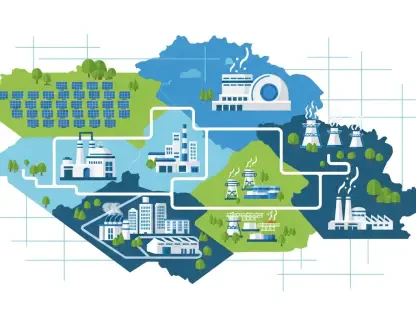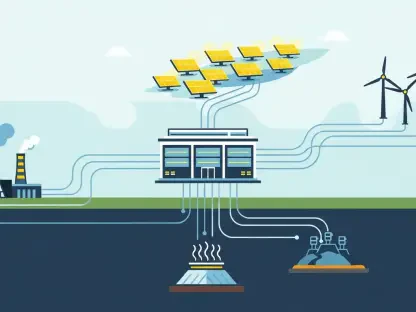In the ever-evolving world of utilities, a new strategy has emerged to address the complexities of investment decisions—behind-the-meter flexibility. As geopolitical and economic uncertainties increase, this approach, often referred to as non-wires alternatives, is becoming a pivotal part of many utility companies’ strategic plans. Traditional utility investment models have increasingly been complicated by factors such as inflation, tariffs, and extreme weather conditions. This shift to behind-the-meter flexibility offers a compelling strategy to navigate these unpredictable environments.
By focusing on optimizing existing systems rather than relying solely on conventional power plants and infrastructure, utilities can better manage the demand for clean, affordable, and reliable energy. The drive towards electrification, coupled with the rise of data centers and industrial onshoring, has made it imperative for utilities to find innovative solutions that meet the growing energy needs. This transformation is not just need-based but also rewards-driven, presenting numerous benefits to utility companies that manage to harness its potential.
Navigating the Challenges of Energy Infrastructure
The Investment Dilemma in Utilities
Utilities today are confronted with a multifaceted challenge as they try to balance demand growth with the need for sustainable investment. The proliferation of data centers and the electrification of transportation and homes have exacerbated pressure on already strained power grids. Utilities must deal with a litany of issues, from prolonged construction periods for new generation assets to the inflationary pressures impacting operation costs. Combined with geopolitical disturbances impacting fuel supply, this creates an environment fraught with uncertainty. Traditional investment strategies are no longer sufficient to manage such hurdles efficiently.
As a result, the industry is pivoting toward innovative strategies like behind-the-meter flexibility, emphasizing investments in distributed energy resources (DERs). DERs, such as solar panels and battery storage, allow for a decentralized approach to energy management. When integrated correctly, these resources can alleviate some of the pressure from the main grid by providing supplementary power during peak demand periods. Additionally, recent years have seen an upsurge in the deployment of electric vehicles (EVs), which, with the right infrastructure, could also provide energy back to the grid.
The Case for a No-Regret Strategy
In the search for stability, utilities are increasingly adopting what is termed as “no-regret” investments. The emphasis here is on low-risk ventures that offer high rewards by enhancing the efficiency and resilience of existing infrastructure. Regularly, these investments focus on utilizing existing assets more effectively rather than building new ones. Investing in systems that can withstand both current and future demands is critical, considering the volatile landscape shaped by regulatory and political considerations. Utilities are actively exploring frameworks that allow for flexibility and adaptability, such as virtual power plants (VPPs).
VPPs use technology to aggregate the capacities of various DERs, optimizing them in real-time to mimic the functionality of a traditional power plant. This not only lessens the dependency on constructing new generation facilities but also significantly reduces investment risks. These platforms can dynamically shift resources to where they are needed most, creating an agile system capable of responding to sudden shifts in energy demand or supply conditions. The potential cost-saving and efficiency implications of adopting such a system are substantial, offering utilities a viable pathway to managing unpredictable scenarios.
Innovating Through De-centralization
Aggregating Distributed Energy Resources
The integration of distributed energy resources presents a powerful opportunity for utilities to tackle the dual challenges of demand growth and grid reliability. However, to fully leverage this potential, the industry must shift from fragmented deployments to systems characterized by interconnectivity and coordination. Currently, less than a quarter of residential solar energy setups include battery storage—demonstrating the disparate nature of resource deployment. Although these resources are deployed extensively, their value is often diminished due to lack of integration with utility systems.
For real impact, it is crucial that these disparate elements are harmonized into a cohesive system. VPPs act as a bridge, enabling a coordinated and optimized use of behind-the-meter resources. By tapping into such synergies, utilities can defer traditional investments in infrastructure, thus saving on costs associated with overbuilding. The VPP model empowers utilities with the flexibility of capacity when and where it’s necessary, creating a win-win situation whereby both the utility and the consumer can benefit from a more reliable and robust energy supply system.
Diversifying Energy Supplies
Addressing the risk of relying on volatile fuel markets is another avenue where behind-the-meter flexibility demonstrates its merits. By making full use of the untapped capacity from diverse DERs, utilities can reduce their dependence on fossil fuels and better navigate supply chain vulnerabilities. This approach includes aggregating energy from solar arrays, battery storage, and burgeoning vehicle-to-grid (V2G) systems, each equipped to supply surplus energy back into the grid. Such diversity in energy supplies contributes to a more stable grid by insulating it from geopolitical or market-induced pricing spikes.
Utilities that implement VPP frameworks—using technology-agnostic platforms—enjoy more robust capabilities to absorb market fluctuations. Not having to rely solely on foreign fuel sources simplifies the planning landscape and reduces exposure to sudden changes in energy prices. As utilities continue to look for ways to enhance their operational resilience, embracing a diversified energy resource platform becomes not just an ideal but a necessity for future success.
Strategic Adaptation to Emerging Conditions
Leveraging Flexible Solutions
The modern energy sector is marked by rapid technological changes, demanding that utilities be adaptable and forward-thinking. By embracing flexible energy solutions, utilities can future-proof their operations against unforeseen challenges. Many utilities are now leveraging SaaS platforms that offer scalable solutions to harness additional capacity. These platforms present a cost-effective alternative to direct ownership of new generation assets, instead facilitating partnerships that allow utilities to access energy on an as-needed basis. Such strategies translate not only into cost savings but also operational agility.
Partnerships enable utilities to expand capacity without incurring the traditional financial burdens associated with infrastructure development. By utilizing customer-owned resources, like domestic solar panels or home-based battery systems, utilities can distribute energy more evenly across the grid, achieving balance without deep financial commitments. This strategic approach is particularly appealing in today’s environment where long-term power purchase agreements may risk financial viability under volatile conditions.
Adapting to Potential Future Scenarios
In an industry fraught with uncertainties, the ability to perform across various future scenarios is a significant competitive advantage. Energy orchestration solutions derived from behind-the-meter resources allow utilities to reconfigure assets to match evolving demand dynamics. This flexibility is invaluable, offering utilities an evolved toolkit to deal with potential regulatory, geopolitical, or market-based disruptions. Such resilience ensures that utilities remain viable and responsive amid changing technological landscapes.
The integration of behind-the-meter flexibility into utility strategies is no longer just about addressing present-day challenges. It is about anticipating and preparing for the myriad conditions the future may hold. By investing in systems that are dynamic yet reliable, utilities can not only survive but thrive amid the unpredictable contours of the energy sector.
The Path Forward in Energy Management
In the rapidly changing landscape of utilities, a fresh approach called behind-the-meter flexibility is reshaping how investment decisions are made. As geopolitical and economic uncertainties grow, these non-wires alternatives are becoming increasingly crucial in strategic utility planning. Traditional investment models for utilities have faced escalating challenges due to variables like inflation, tariffs, and severe weather events. This pivot to behind-the-meter solutions offers a robust method for dealing with unpredictable conditions.
By prioritizing the optimization of current systems over the exclusive use of traditional power plants and infrastructure, utilities can more effectively meet the demand for clean, affordable, and dependable energy. The transition to electrification, along with the increasing prevalence of data centers and industrial onshoring, necessitates that utilities adopt innovative strategies to cater to the rising energy demands. This shift is both necessary and beneficial, providing substantial advantages to utility companies that successfully tap into its potential.









